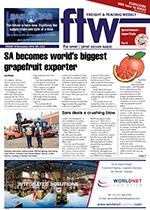As southern African citrus exports hit record highs, industry leaders have raised concern about “disappointing” returns. According to John Edmonds, information manager for the Citrus Growers’ Association (CGA), total packed volume at the end of week 45 was just over 135 million 15-kilo cartons, surpassing last year’s 123 million. “Our latest prediction is that we will end the season with 135.2 million cartons,” he said. “This is against an original estimate of 131.7 million.” Edmonds said record exports had been seen across the board with South Africa becoming the world’s biggest grapefruit exporter. The current tally for grapefruit is 16.5million 17kg cartons. It’s considered a risky crop with low margins which is why many growers around the world have opted to pull out of the sector, but South African farmers have stuck with it – a move that has paid off as they are now a dominant force in the market. The same is true of oranges. Edmonds said whilst Northern Europe remained the biggest market for grapefruit, with some 70 000 tons exported to this region in 2018, massive growth had been seen in China with around 50 000 cartons of grapefruit going to that country. South Africa also saw a record Valencia crop this year with 54 million cartons packed compared to the 53.8 million in 2017. “The orange season was marked by a slow start due to significantly higher volumes of Egyptian oranges lingering longer in the market,” said Edmonds. It was a phenomenon that was expected to become a permanent feature in the orange exporting landscape and South African producers would have to learn to contend with this going forward, he added. Navel packing volumes in 2018 were just over 26.6 million cartons – a 26% increase on last year’s 21.1 million cartons, recovering from the Eastern Cape’s disastrous 2017 season. Europe and the Middle East remained the top destinations for oranges, receiving 26% each of the export volume. Edmonds said lemon exports from the southern hemisphere countries had grown about 6% from around 620 500 tons last year to just under 660 000 tons at the last count. Soft citrus also performed well with exports of around 16.1 million cartons this year, up 26% on last year. “The UK (28%) and Europe (25%) in 2018 together take over half of South Africa’s export of soft citrus,” said Edmonds. “The UK took 4.4 million cartons in 2018 compared to four million cartons by week 39 last year, up 11%. Europe took almost four million cartons in 2018 compared to 3.36 million cartons by week 39 last year, up almost 18%.” According to Justin Chadwick, CGA CEO, the record crop did put pressure on the markets to perform. “Although we do not have the figures on what returns growers achieved, the talk is that returns in many markets were disappointing,” he told FTW. “The other challenge was in getting the record crop to and through the ports. The volume of fruit requiring long haulage has increased. Coupled with this is the fact that delivery to the port is over a 4 to 6-week peak period, resulting in big demand for trucks. When the product gets to the port the infrastructure in the port precinct (especially Durban) is constrained.” He said cold store facilities became blocked out and inspectors to inspect the fruit could not always keep up with demand. “Also, the new requirements in the EU with False Codling Moth were a real challenge,” said Chadwick. “Developing, implementing and fine-tuning a new system in a short period of time is difficult – and many lessons were learnt. Fortunately, growers, government and other role-players performed admirably well, with limited phytosanitary interceptions in the EU.” Commenting on future challenges, Chadwick said opening new markets was at the top of the list. “Also optimising present market access and retaining markets so that additional demand matches the known increase in supply remains a challenge,” he said.
INSERT with CAPTION
The talk is that returns in many markets were disappointing. – Justin Chadwick

